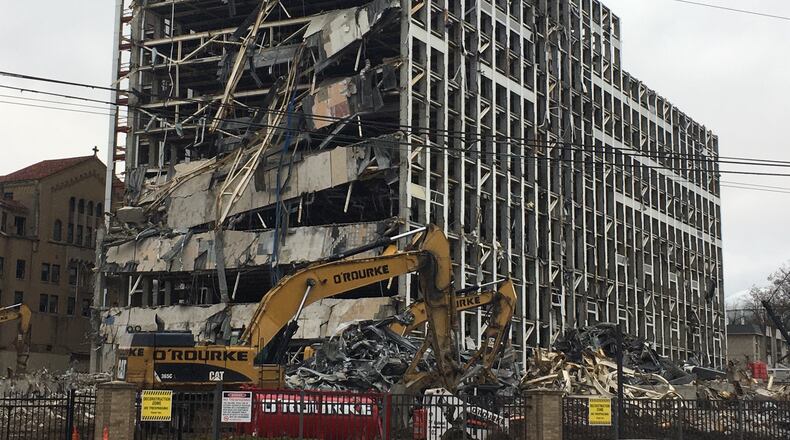Over a 10-year period, Premier Health will provide $15 million for Phoenix board-approved activities that will be matched by $15 million from the city of Dayton through traditional public fund sources. In addition to this $30 million commitment, the partners will work to use this money to bring in state, federal and private philanthropy dollars to redevelopment efforts.
MORE: Good Sam site plan shared at community meeting
In January, Premier Health and CityWide Development shared an outline to guide redevelopment at the property, though on Monday new details were revealed on how the goals will be carried out.
The 13-acre hospital campus at the intersection of Salem Avenue and Philadelphia Drive is still under demolition. Premier Health officials plan to tear down the hospital campus with the exception of the parking garage and Five Rivers Health Centers, which will continue to operate on site.
Mary Boosalis, president and CEO of Premier Health, said the health system takes its responsibility as a corporate citizen seriously, and wants to do its part to attract significant reinvestment and energy to the neighborhoods surrounding the former Good Samaritan Hospital campus.
“You need not look far in this part of our city to find evidence of companies that walked away and left the area with blighted structures and more limited opportunity. We have been determined from day one to keep the community’s long term success in mind throughout this transition,” Boosalis said.
MORE: $29M infrastructure needed for onMain early phases
As part of that commitment, Premier Health will in addition cover expenses associated with preparing the former Good Samaritan Hospital site for redevelopment.
Whaley said the city’s pledged money will come from different sources such as from the demolition work, work they will push for with economic development, and through street improvements.
“So we’ve identified ways to squeeze more money out to particularly focus on Salem Avenue and northwest Dayton,” Whaley said.
Finding a vision for the area
Also Monday, Premier and the city of Dayton released a “Re-use and Investment Vision” for the area immediately surrounding the former Good Samaritan Hospital campus.
MORE: A year later, hospital system stands behind Good Sam closing
The general goals of the outline were to support health and wellness and next generational learning, with a detailed outline of the strategy on daytonphoenixproject.org.
The hospital employed 1,600 at the main campus when the closing was announced in January 2018.
Civil rights complaint going forward
There’s still a civil rights complaint about the closure pending before the U.S. Department of Health and Human Services, filed by a group of clergy who said the loss of the hospital violates the civil rights of black residents and of women, by removing key services such as the emergency room and the maternity unit from the hospital’s majority-black service area.
The complaint was later expanded to criticize the nonprofit health system for continuing to find the resources to expand in mostly white wealthier parts of the community while closing Good Samaritan.
Premier officials said they do not believe the allegations have merit.
Premier has said with fewer people spending the night in hospitals and the city population declining, it made the difficult but fiscally responsible decision of closing the hospital, instead of keeping the outdated campus open when they had another hospital less than five miles away.
Rev. Rockney Carter, who led the civil rights suit, was at the press conference and said the announcement is good news, though he’s disappointed that there hasn’t been talk about an anchor health institution like a stand-alone emergency facility such as what Premier has in Jamestown.
“I’m saddened that we got to the $30 million and there’s still no talk of any type of medical facility to handle the trauma, to handle the needs of the constituents. I’m excited that we got from $10 (million) to $30 million and now we’re going to keep plugging away to see if we can get that number even higher.
Premier in the initial announcement of the hospital closing pledged to cover the cost of demolition and to spend $10 million on the site and the nearby neighborhoods, with the goal of using that money to draw other spending or draw down government dollars.
New board formed for project
As part of the redevelopment effort, a new nonprofit organization, Phoenix Next Dayton, will form to guide the redevelopment effort. A new board will be seated in January 2020.
New board members will include:
* Dayton city manager Shelley Dickstein and city planning and community development director Todd Kinskey;
* Eloise Broner and Patrick Ray from Premier Health;
* and community members Sister Carol Bauer —formerly Good Sam’s vice president of Mission Effectiveness — and Belinda Matthews Stenson, formerly a Premier trustee.
“Sister Carol has been with the Phoenix Project since its inception in 2002, so when you talk about a historian, she’s the one,” said Broner, formerly Good Sam president and now chief of shared services at Premier Health. “And then we wanted to talk about someone who has a broader community view … so we tapped Belinda because she is very, very knowledgeable about what is going on not only in the neighborhood but in the broader community as well.”
About the Author
